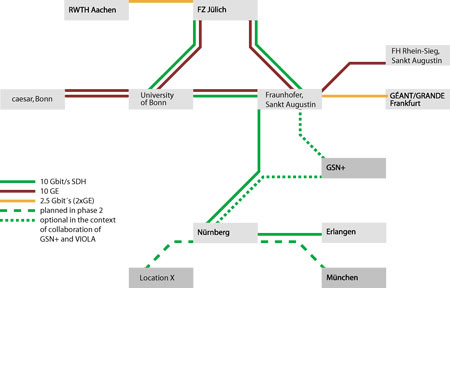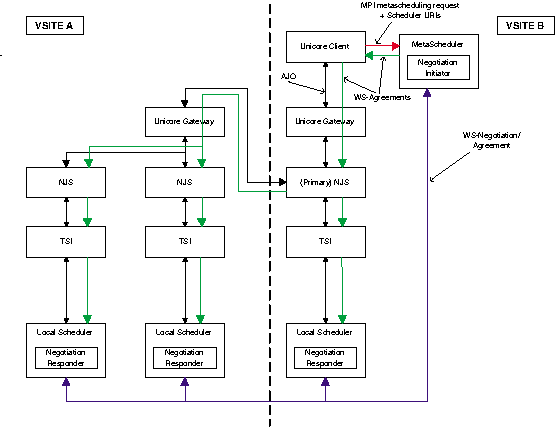|
|||||
Resource Management in an Optical Grid Testbedby Helmut Grund and Wolfgang Ziegler The German Ministry for Research and Education (BMBF) launched the Vertically Integrated Optical Testbed for Large Applications (VIOLA) project in spring 2004. The project is managed by ‘Deutsches Forschungsnetz’ (DFN) and will run for three years. Emerging new technology for optical networks will deliver QoS and bandwidth far beyond the capacity and capabilities of today’s networks. For the evaluation of new network components and architecture, the integration of network techniques and applications has proven a success in former testbeds. The technical basis of the testbed is comprised of optical network components connecting compute resources, from which a grid based on the UNICORE system is built up. To allow large complex applications stressing the capabilities of the underlying optical network, additional grid components will be adopted, including a MetaScheduler (allowing co-allocation of compute resources, network resources with the necessary QoS or other resources like visualization devices) and MetaMPICH communication libraries for distributed applications using MPI for interprocess communication.
The expected outcomes of the project are threefold. First, new network techniques will be deployed and tested in an optical testbed, and along with ambitious applications will provide know-how for future generations of networks, especially the next generation of the German NREN X-WIN. Second, the enhanced Grid middleware originating from the project will become useful in the German e-Science Initiative D-Grid. The third important aspect of the project is the collaboration with other projects on a national, European and international level. The consortium of the project is led by the DFN, ranges from research institutes and universities to the telecommunication industry, and includes Research Centre Jülich, Fraunhofer Institute for Scientific Computing and Algorithms (SCAI), Fraunhofer Institute for Media Communication (IMK), the Centre of Advanced European Studies and Research (CAESAR), RWTH Aachen University, Bonn University, the University of Applied Sciences Bonn-Rhine-Sieg (FHRS), Alcatel SEL AG, Siemens AG and T-Systems International GmbH. VIOLA-Support for Set-Up and Operation of the Grid
Interaction with network resources is needed on two levels. The first is scheduling of network resources through dedicated (local) resource management systems in a similar way to compute resources today, whereas the resource management system for (optical) switches of the testbed implements the necessary protocol. The implementation of the resource management system is done by Fraunhofer IMK and Bonn University. The second is co-allocation of network and compute resources for a given task of the user. This will be done through implementation of WS-Agreement and WS-Negotiation as proposed by the Global Grid Forum working group GRAAP (Grid Resource Allocation Agreement Protocol). Two requirements for local scheduling systems must be satisfied: local systems must handle the negotiation protocol, and must be able to do advance reservation of resources for a negotiated time-slot. These requirements also guarantee maximum local site autonomy, since the negotiation respects the local scheduling mechanisms and site policies remain fully effective. User authentication and mapping is handled by the local UNICORE system as usual. Current State of the Project Future Plans Finally, another objective of VIOLA is to connect to similar projects on a European and international level; these include the Canadian CANARIE, the Czech CESNET, the Polish PIONIER, the British UKERNA and the Dutch SURFnet. Efforts to establish these connections and create joint projects will be made starting in 2005. Links: Please contact: |
|||||




